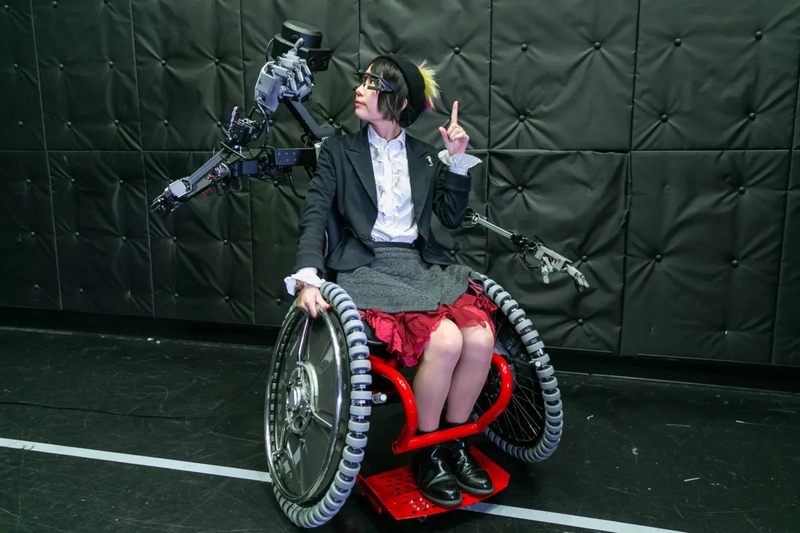From VRChat Cat Ears to Human Augmentation: Ever Thought You'd Need Extra Robotic Arms?

Metaverse | Extended Reality
6-minute read
"Soul" might just be my favorite Pixar movie in recent years.
The protagonist Joe, an underappreciated musician, dreams of joining a jazz band. Just as his piano skills are finally recognized and his dream is about to come true, a sudden accident sends his life into a tailspin, forcing him to start over. The movie kicks off with this unexpected twist, showcasing the screenwriter's impressive skills. The film doesn't disappoint as it progresses, offering a richly imaginative depiction of the soul's journey before being born on Earth.
However, there are some perplexing elements in the film, such as souls inhabiting cats or swapping bodies. These transitions seem too easy, prompting me to ponder the compatibility between mind and body. How does a mind adapt to and control a completely new body? Even Peter Parker, bitten by a radioactive spider, needed time to adjust. So what about a cross-species body swap?
 Does anyone else love "Soul" as much as I do? (Source: Pixar)
Does anyone else love "Soul" as much as I do? (Source: Pixar)
Could the relationship between our physical bodies and virtual avatars be related to the issue of mind-body compatibility? Consider how members of the furry fandom joyfully navigate their VRChat avatars, complete with cat ears or a wolf's tail. Isn't this similar to a soul inhabiting the body of another species? Of course, humans have ears too, but not everyone can make them twitch adorably, nor can they control a tail that disappeared somewhere along our evolutionary path.
Human Augmentation: The Third Arm
In the virtual world like VRChat, we can control limbs that don't exist in our physical bodies. But is this possible in the real world? Curiosity led me to discover the "Third Arm" research at the École Polytechnique Fédérale de Lausanne (EPFL).
The concept of a third arm might sound odd, but it's not as complicated as it seems and is quite practical.
Imagine this common scenario: You're carrying a heavy package and need to open your front door. You have to put the package down, fish out your keys, open the door, pick up the package again, and then awkwardly kick the door shut. Wouldn't it be great to have a third arm to help with the keys and the door? That's the idea behind the development of the third arm.
In short, neuroengineers at EPFL have developed a mechanical arm controlled by the diaphragm.
When discussing human-machine integration and controlling prosthetics with brainwaves, we often assume it will bring revolutionary changes for people with disabilities. But for able-bodied individuals, this falls under the field of "human augmentation," or as the researchers call it, "Extra Robotic Arms" (XRAs).
Indeed, EPFL's research builds on previous studies aimed at providing tactile feedback for amputees' prosthetics. This time, however, the goal is human augmentation. By controlling a third arm that didn't previously exist, researchers aim to further understand the mysteries of how the neuro system and brain work together. It feels a bit like buying gorilla arms on the black market, doesn't it?

In the experiment, participants learned to control the third arm through VR. (Source: EPFL)
After putting on the VIVE Pro Eye headset, participants see themselves with three arms: a left arm, a right arm, and a third one in the middle. Giulia Dominijanni, a co-author of the research paper, explains that the third arm was made symmetrical to avoid any bias towards the left or right hand. This means the 'symmetrical' arm has six fingers, with a thumb on each side (can it give a thumbs-up?).
You might wonder why the diaphragm is used to operate the arm. Does it hold some secret power?
Dominijanni continues to explain that they wrapped a belt around the participants' diaphragms to measure its movement and successfully operate the arm. This is because using the diaphragm interferes least with the users' breathing and speaking. After more than 150 VR training sessions, the 61 healthy participants learned to operate the third arm. “One of the biggest challenges in the development of XRA lies in the implementation of control strategies that do not hinder natural abilities or the functionalities of biological limbs,” Dominijanni explained.
“We want to understand if our brains are hardwired to control what nature has given us, and we’ve shown that the human brain can adapt to coordinate new limbs in tandem with our biological ones,” explains Solaiman Shokur, another author of the paper. “It’s about acquiring new motor functions, enhancement beyond the existing functions of a given user, be it a healthy individual or a disabled one. From a nervous system perspective, it’s a continuum between rehabilitation and augmentation.”
 You can use your diaphragm to operate a simplified third arm between breaths. (Source: EPFL)
You can use your diaphragm to operate a simplified third arm between breaths. (Source: EPFL)
EPFL's "Third Arm" research aims to achieve human-machine integration, offering new prosthetic possibilities for people with disabilities and enhancing the capabilities of healthy individuals. What once seemed like science fiction, such as Tony Stark's Iron Man suit or Spider-Man's villain Doctor Octopus, is now entering the realm of reality. To wrap up, here are three interesting examples of human-machine integration and human augmentation that might satisfy your curiosity.
Jizai Arms
Developed by the University of Tokyo, the "Jizai Arms" resemble the Kamajī (釜爺, lit. "Boiler Geezer") from "Spirited Away." This wearable backpack can accommodate up to six arms and is designed for human augmentation. Although these mechanical arms look cool, they don't have much practical use—you can't truly control them, but you can interact with them to simulate what it might feel like to be a creature with eight arms.
Interestingly, the University of Tokyo's experiments show that participants felt a sense of loss when they reduced the number of their Jizai Arms, suggesting that humans can develop an emotional connection to mechanical limbs, similar to natural ones. This implies that non-biological devices, once integrated into our daily activities and identity, can become an inseparable part of our emotional lives.
 This is probably an attempt at human-machine symbiosis. (Source: YouTube)
This is probably an attempt at human-machine symbiosis. (Source: YouTube)
EksoVest Exoskeleton
The EksoVest is an exoskeleton vest developed by Ekso Bionics, a company specializing in robotic exoskeleton technology. Their product range covers medical, military, and labor-intensive industries. The EksoVest, in particular, is designed to reduce the strain on workers' shoulders and upper backs during tasks that require frequent arm lifting. It's powered by spring mechanisms rather than motors, making it lightweight and easy to wear.
Perhaps wearing an EksoVest could save a lot of effort on moving day?
 Just reducing occupational damage is very practical. (Source: YouTube)
Just reducing occupational damage is very practical. (Source: YouTube)
SlideFusion Wheelchair
Developed by Yamen Saraiji, a research scientist at Sony AI, SlideFusion is a practical innovation for wheelchair users. Saraiji's starting point was the idea that wheelchair users, who typically use their hands to push the wheels, could benefit from mechanical arms. SlideFusion uses eye-tracking to control the mechanical arms, allowing users to meet most of their daily needs without verbal commands or additional communication. It also integrates with the VIVE Pro Eye, which features eye-tracking, to enable remote control of the mechanical arms for collaboration with people with disabilities.
This innovation shares similarities with the German team NimbRo's use of VR to control robots, reducing the risks of space missions.

A robotic arm that can understand what you want to do just through eye tracking, is this considered a form of reading the room? (Source: Welcome to MYamenS)
From manipulating cat ears in VRChat with brainwaves to initiatives like the third arm, these human augmentation projects inevitably bring to mind the ancient Greek philosophical dilemma of Theseus' ship. Whether it's the "tool theory" of AI enhancing human productivity, or the various human augmentation products and research we've highlighted, they all introduce "change" to our lives (without immediately judging it as good or bad). One thing becomes increasingly clear—technology is constantly reshaping our understanding of what it means to be human.
Fortunately, philosophical discussions on cyborgs, the body, post-humanism, and science fiction narratives such as "Ghost in the Shell," where human souls can connect through the internet, "Death Stranding 2" featuring Lea Seydoux's character with four arms (two for covering her nose), and the imaginative world of the "Cyberpunk" series with Sandevistan and the concept of cyberpsychosis, provide endless examples and intriguing settings. These are essentially thought experiments that have laid the groundwork for our path to the future.
